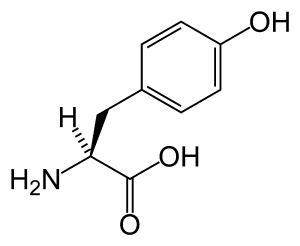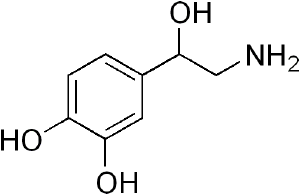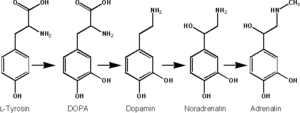Difference between revisions of "Catecholamine" - New World Encyclopedia
Katya Swarts (talk | contribs) (added article and credit tags) |
({{Contracted}}) |
||
| Line 1: | Line 1: | ||
| + | {{Contracted}} | ||
[[Image:L-tyrosine-skeletal.png|thumb|[[tyrosine]] is the precursor of catecholamines]] | [[Image:L-tyrosine-skeletal.png|thumb|[[tyrosine]] is the precursor of catecholamines]] | ||
[[Image:Adrenaline.svg|thumb|[[epinephrine]]]] | [[Image:Adrenaline.svg|thumb|[[epinephrine]]]] | ||
Revision as of 15:27, 31 July 2007

Catecholamines are chemical compounds derived from the amino acid tyrosine containing catechol and amine groups. Some of them are biogenic amines. Catecholamines are water soluble and are 50% bound to plasma proteins, so they circulate in the bloodstream. The most abundant catecholamines are epinephrine (adrenaline), norepinephrine (noradrenaline) and dopamine, all of which are produced by phenylalanine and tyrosine. Tyrosine is created from phenylalanine by hydroxylation thanks to the enzyme, phenylalanine hydroxylase (tyrosine is also ingested directly from dietary protein). Tyrosine is then sent to catecholaminesecreting neurons. Here many kinds of reactions convert it to dopamine, to norepinephrine and epinephrine eventually.[1] Catecholamines as hormones are released by the adrenal glands in situations of stress such as psychological stress or low blood sugar levels[2].
Production
Catecholamines are produced mainly by the chromaffin cells of the adrenal medulla and the postganglionic fibers of the sympathetic nervous system. Dopamine, which acts as a neurotransmitter in the central nervous system, is largely produced in neuronal cell bodies in two areas of the brainstem: the substantia nigra and the ventral tegmental area.
Function
Modality
Two catecholamines, norepinephrine and dopamine, act as neurotransmitters in the central nervous system and as hormones in the blood circulation. The catecholamine norepinephrine is a neurotransmitter of the peripheral sympathetic nervous system but is also present in the blood (mostly through "spillover" from the synapses of the sympathetic system).
High catecholamine levels in blood are associated with stress, which can be induced from psychological reactions or environmental stressors such as elevated sound levels, intense light, or low blood sugar levels.
Extremely high levels of catecholamine (also known as catecholamine toxicity) can occur in CNS trauma due to stimulation and/or damage of nuclei in the brainstem, particularly those nuclei affecting the sympathetic nervous system. In emergency medicine, this occurrence is widely known as catecholamine dump.
Effects
Catecholamines cause general physiological changes that prepare the body for physical activity (fight-or-flight response). Some typical effects are increases in heart rate, blood pressure, blood glucose levels, and a general reaction of the sympathetic nervous system. Some drugs, like tolcapone (a central COMT-inhibitor), raise the levels of all the catecholamines.
Structure
Catecholamines have the distinct structure of a benzene ring with two hydroxyl groups, an intermediate ethyl chain and a terminal amine group.
Degradation
They have a half-life of approximately a few minutes when circulating in the blood.
Monoamine oxidase (MAO) is the main enzyme responsible for degradation of catecholamines.
Methamphetamine and MAOIs bind to MAOs to inhibit their action of breaking down catecholamines. This is primarily the reason why the effects of amphetamines last longer than cocaine and other substances. Amphetamines not only causes a release of dopamine, epinephrine, and norepinephrine into the blood stream, but also keeps it working there for a long time.
See also
- Catechol-O-methyl transferase
- Hormone
- Julius Axelrod
- Phenethylamines
- Steroid hormone
- Peptide hormone
- Sympathomimetics
- Vanillyl mandelic acid
ReferencesISBN links support NWE through referral fees
- ↑ [1]
- ↑ "Hypoglycemia" by Ronald Hoffman, M.D., July 1999, The Holistic M.D.
External links
- MeSH Catecholamines
Credits
New World Encyclopedia writers and editors rewrote and completed the Wikipedia article in accordance with New World Encyclopedia standards. This article abides by terms of the Creative Commons CC-by-sa 3.0 License (CC-by-sa), which may be used and disseminated with proper attribution. Credit is due under the terms of this license that can reference both the New World Encyclopedia contributors and the selfless volunteer contributors of the Wikimedia Foundation. To cite this article click here for a list of acceptable citing formats.The history of earlier contributions by wikipedians is accessible to researchers here:
The history of this article since it was imported to New World Encyclopedia:
Note: Some restrictions may apply to use of individual images which are separately licensed.



